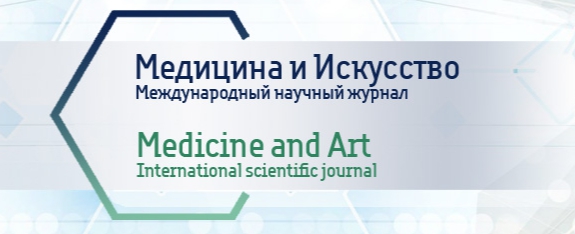Россия
УДК 781.1 Научные основы. Математические, физические, психологические теории. Музыкальная акустика
Индийская классическая и духовная музыка имеют богатые традиции и большую историю применения в лечении и поддержании здоровья человека. В этом отношении они тесно связаны с Нада йогой. Эти эффективные практики основаны на древнем знании и опыте, собранном за тысячи лет, что сейчас представляет большой интерес. Целостный подход к понятию «Здоровье» подразумевает представление о физическом теле человека как лишь части системы, включающей и другие тонкие энергетические слои – коши – и имеющего соответствующую энергетическую структуру. Эта статья знакомит читателя с Индийской музыкальной системой в целом и с Рагой, её неотъемлемым элементом, а также с Нада йогой, являющейся древней системой знания и способной дать новый свежий взгляд на музыкальную терапию. Очень важно осмыслить эти достижения Индийской цивилизации с позиций современной науки. Мы постараемся разобраться в том, как работает духовный звук или мантра, и научные факты, лежащие в её основе – частоты – и их влияние на тело и ум человека. В чём польза и уникальность Индийской классической и духовной музыки, и, следовательно, как она может быть использована в лечении и поддержании здоровья человека. Эта статья составлена из материалов, которые давались русским студентам на занятиях по Нада йоге автором настоящей статьи (параллельно с обучением Индийскому классическому вокалу) и основана на выполняемой в данный момент диссертационной исследовательской работе «Музыкальная Нада, Мантра, Стути и их влияние на тело, ум и душу человека», проводящейся на базе Университета Р.М.Т. Кала Сангит Вишвавидьялайа, Гвалиор, Индия.
Музыкальная терапия, Индийская классическая музыка, Мантра, Чакры, влияние нотных частот, Индийская рага, Индийская исцеляющая музыка, польза пения
NTRODUCTION
The goal of this article is to give a short introduction of the immensely rich ancient Indian traditions regarding to Musical Therapy. For a long time, this knowledge was hidden and was transmitted only through musical family generations or from the teacher to disciple. On the other side, it was counted as non-scientific by the scientific society because of lack of understanding and absence of research works.
It is said that everything, that is new, is already forgotten knowledge of the past. Nowadays scientists search for the inspiration in the ancient holistic knowledge, and that’s why more and more researchers apply to ancient Indian scriptures, and with the modern methods they prove what was found thousands of years ago.
The author hopes, that this article will inspire talented scholars for the further studies and researches to find new methods of healing and healthy life style.
Definition of health
According to the World Health Organization, health is «a state of complete physical, mental and social well-being»[1]. In Indian tradition of Yoga, «health consists of physical, mental, social, vocational, moral, emotional and spiritual dimensions»[2]. The very word “Yoga” came from Sanskrit word «yoke», which means union – the union of body, mind and soul.
ANCIENT DOCTRINE OF NAAD YOGA
Concept of Panchkosh or five bodies
According to the ancient knowledge, human body is not only what we can see with eyes. There are five «bodies», and physical body is only one among them. Other «bodies» are so called «subtle bodies», which cover the soul like we can see on Russian Matryoshka souvenir toy (Fig.1).
Five «bodies» are[3]:
- Physical (Annamaya kosh) – we can feel it with our five senses;
- Energetic (Pranamaya kosh) – Aura and energy movement (Prana);
- Mind (Manomaya kosh) – thoughts, emotions, feelings, fears etc;
- Higher Mind/Wisdom – inner consciousness, inner voice, belief systems, intellect, values;
- Bliss (Anandamaya kosh) - the thinnest «body», which is composed of happiness – happiness without any cause. It is associated with the state of dreamless sleep and self-realization.
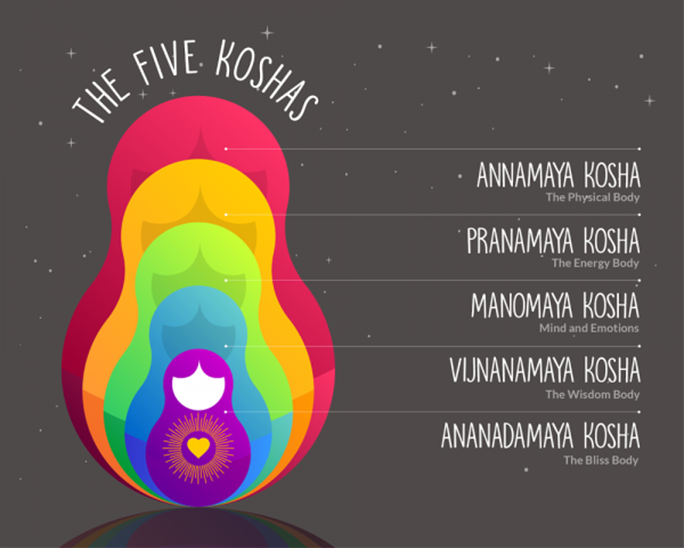
Fig.1. The five koshas
Рис.1. Пять кош
According to this holistic view any illness or disorder comes from the subtler «bodies» down to the solid physical body. This knowledge finds prove in the modern psychosomatical researches. We heard from childhood that by word we can kill or heal, and that all diseases come out of stress.
Our different «bodies» or layers can be affected by different means – the subtler layers can be affected by subtle means and our physical body, which consists of five elements, we treat with same solid means (medical treatment, chemical therapy etc).
Naad Yoga. Definition of Naad
Present research concentrates on a particular field of Yoga – on Naad yoga. Naad yoga is union of body, mind and soul through and by the naad. Naad is the base of all vibrations, it is the energy of vibrations, so called «cosmic sound».
Naad is continues flow of energy, which never stops, like time (it is everywhere - in human body, in nature, in universe).
Everywhere there are energies of so many types. For life we have «to charge», like we use to charge mobile (charging starts, when 3 things are there: 1) mobile/equipment; 2) wire/channel of energy flow with the right charger, suitable for this very mobile; 3) power supply/source of energy. To charge ourselves we should know the System, and how it works, and master the art to connect with the energy flows.
Everything, that never ends, have some supportive vibration, and every flow movement requires some «vehicle». For naad that «vehicle» is sound. The sound is everywhere, it accompanies every process, it is the first element of nature.
Behind every structure there is some energy vibration, and every structure comes like three in one: word – image – vibration/energy.
According to Vedas[4] this structure is described in terms:
- Akshar Brahman[5] – words/alphabets;
- Rup Brahman – visible form;
- Naad – vibration.
How can we feel this? We say any word - for example «MAMA». Immediately with this word some image comes to our mind, and also some energy vibration we may feel. If that connection with the energy flow has happened and it is continuing in the body for some time – that is Naad.
Some frequency of sound we can hear (speech, singing, etc), and that vibration is called Aahat Naad – this sound is created by some stroke. Those vibrations, which our listening ability cannot catch, we call Anahat Naad, it is not created by any stroke. Though we can’t hear that, it influences our subtle «bodies» – our energy layer, our mind and others. This Naad «journey» starts in Akar Brahman – the world of forms and structures, and goes to Nirakar Brahman, which has no form.
Five elements concept or Panchbhoot
Human body being a part of nature consists of five elements of nature: earth, water, fire, air and ether. First four elements we aware about: food (earth element) we eat, and it constructs the body; liquids (water) we drink, and it constitutes our inner waters; some energy process provides digestion (breakdown of large insoluble food molecules into small water-soluble food molecules) – it is fire element in our body; air we require for breathing. But what is ether element? That is energy and that is sound.
Energy system of the human body and chakras
At schools we study anatomy, and we know that there are different systems in our body: digestive, lymphatic, circulatory, respiratory, nervous and other systems. There is also another one system in our body, which we do not study at school because it is very subtle – that is energetic system. It also has its structure and laws. Similar to nerves or veins, energy movement in the body goes through some channels, and the places, where bigger channels join, form some kind of nodes. In human body there are 7 big energetic points, which in scriptures of Yoga calls «chakras» (Fig.2). Literally chakra[6] means «the wheel», and they are described as spinning disks of energy, which correspond to bundles of nerves, organs and areas of energetic body that affect our emotional and physical well-being. [1]

Fig.2 Seven chakras and seven levels of consciousness
Рис.2. Семь чакр и семь уровней сознания
According to this knowledge of energetic system of the human body, each emotion or feeling is located at the particular point. Any disbalance in these main energetic points will lead to some kind of disease. Some western scientists and psychotherapists have already started to use this knowledge in practice (for example, vegetotherapy or body-oriented psychotherapy, based on Wilhelm Reich researches, successfully uses this). [2, 3]
The sound (ether element) and the naad (as its root) affects whole energetic body and all chakras. By singing all chakras are connected, that’s why singing is effective practice for the physical and psychological well-being.
INDIAN MUSICAL SYSTEM. RAAG
Now the question is there – is any kind of music and any kind of singing equally effective on human body? To understand this, we need to appeal to the musical science.
In Indian musical tradition there is a different note system. Each note has a name and some image behind. Each note will affect some particular part of the body. Some set of notes, placed in a typical order, in which they appear in melodies, and characteristic musical motifs form the raag. Raag is «a central feature of the classical Indian music tradition, and being very unique, it has no direct translation to concepts in classical western music. In Sanskrit, raag can be translated as «something that colors your mind», for it has the power to create very specific emotions or moods in one’s mind»[7]. Thousands of raagas are known, but there are six base raagas, out of which all others come. For any kind of emotion there is some special raag, there are male and female raagas, and some raagas are associated with a particular time of the day or of the year.
Raag involves several important elements:
- Naad – sound vibration, manifestation of the ether energy;
- Pitch, relegated into Swar (whole or half tone/note) and Sruti (microtones);
- Ras – emotional effects in the performer and listener, «aesthetic delight». A performer with sufficient knowledge and training can create the desired moods and emotions through the combination of shrutis and swars. There are nine rasas:
- Wonder (Adbhut),
- Love (Shringar),
- Heroism (Veer),
- Disgust, grotesque (Veebhatsa),
- Anger (Rudra),
- Humour (Hasya),
- Terror (Bhayanak),
- Pathos, tragic (Karuna),
- Compassion, peace (Shanta)
- Thaat – scale;
- Taal – rhyme and speed
Raag is based on the principle of a combination of notes selected out the 22 note intervals of the octave. There are 72 melas or parent scales, on which raagas are based. Improvisation is an essential feature of Indian music, depending upon the imagination and the creativity of an artist. A great artist can communicate and instill in his listener the mood of the Raaga.
Every raaga must have at least five notes, starting at Sa, one principal note Vadi, compared with a «King», a second important note («Queen») and a few helping notes. The ascent and descent of the notes in every raaga is very important. Some raagas in the same scale differ in ascent and descent.
All raags are perfectly balanced, all have healing effect and all have deep meaning behind. It is the art of calling and using some healing energy. By raag the whole energy system and pranic body are affected. [4]
MANTRA. HEALING BY SPIRITUAL SOUND
We can say that Raag is the classical instrument of Indian musical therapy, but not the only one. In Indian tradition sound healing is also associated with another term, which is Mantra. [5]
Mantra (sanskr., «manas» = mind, «tra» = tool) is «a sound, word or phrase in Swanskrit, that alters consciousness through meaning, tone, rhyme or physical vibration»[8]. It is considered to be «tool of thought», used as a means of harnessing and focusing the mind. Mantra can be recited in repetitions or chanted with melody.
Each mantra has a meaning behind it, unique vibrational frequency and distinctive healing effects. When chanting a mantra, the individual begins to vibrate within the frequency of that mantra even on physical level. When chanting mantras aloud, the vibrations and movements of the tongue stimulate some of the key glands of the endocrine system, which are responsible for governing and regulating hormones in the body.
Additionally, the soothing and harmonious combination of sound, breath and rhythm – an inevitable outcome of mantra chanting – has a profound impact on the parasympathetic nervous system. This, in turn, slows the heart rate and triggers the body’s healing response. [6]
Connection of mantras and chakras
As it was said before, there are seven chakras (energetic centers) in the body and there are seven notes (and seven colors of rainbow too). Each chakra, according to Yoga science, has its own color and a special mantra – so-called «beej-mantra» (sanskr., «beej» = seed), which is a simple single syllable word, that can be chanted alone or attached to a longer mantra to enhance its power and quality. The best known beej-mantra is OM (or AUM). There is a special healing practice, which is based on singing beej-mantras of chakras on the frequencies of notes. To understand how it works, we have to turn our gaze on some special frequencies of musical notes, which magically correspond to the frequencies of chakras. By correcting the note, we balance the associated chakra and it changes our emotions and mood.
As we can see on the picture below, each chakra has its own special frequency (Fig. 3).
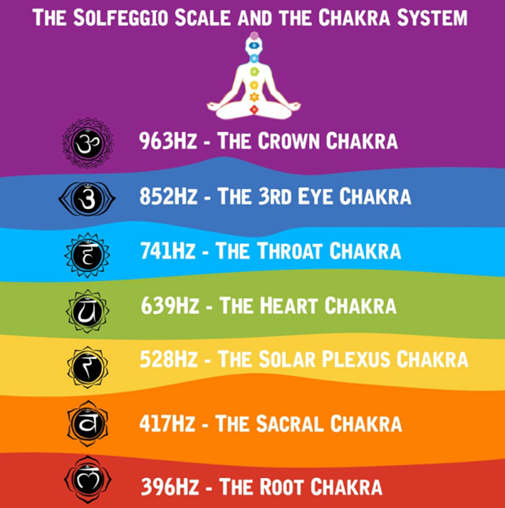
Fig.3. Chakras and their frequencies
Рис.3. Чакры и их частоты
Music is a type of harmonious sound, and sound is a form of energy. Because of its high vibration frequency, we can state that it is a form of positive energy, and everything that resonates with the same vibration, increases its positive energy.
Healing components of the solfeggio frequencies were used long ago in Indian Sanskrit chants. Ancient Indian Yogis referred to some frequency around the Earth as OM the (equal to 7.83Hz). Ivonin & Chang’s study defines the relationship between the archetypal sounds, OM and Solfeggio frequencies and concludes that archetypal sounds are effective in inducing states of meditation and their powerful effect on our subconscious mind and spirit. [7]
FREQUENCIES OF NOTES AND ITS EFFECTS ON HUMAN MIND AND BODY
David Hulse, a famous sound therapist, in his work on «Soma-Energetics» described the effects of some frequencies on human body and mind:
UT – 396 Hz - turning grief into joy, liberating guilt and fear by bringing down defense mechanisms. Associated with Root Chakra Muladhara.
RE – 417 Hz - undoing situations, cleanses traumatic experiences and clears destructive influences of past events, puts in touch with an inexhaustible source of energy that allows to change the life. Associated with Sacral Chakra Swadhisthan.
MI – 528 Hz - transformation, returns human DNA to its original, perfect state, increases amount of life energy, clarity of mind, awareness, awakened or activated creativity. Tone Mi activates imagination, intention and intuition. Associated with Solar Plexus Chakra Manipura.
FA – 639 Hz - re-connecting with family and balancing, relationships, enhances communication, understanding, tolerance and love. Associated with Heart Chakra Anahata.
SOL – 741 Hz - solving problems, cleans the cell from toxins, gives power of self-expression, which results in a pure and stable life. Associated with Throat Chakra Vishuddhi.
LA – 852 Hz - awakening intuition, returning to spiritual order, raises awareness. Associated with Third Eye Chakra Ajna. [8]
Dr. Horowitz continued that research and added some more healing frequencies:
SI – 963 Hz - awakens any system to its original, perfect state, re-connects the individual with the Spirit, enables one to experience Oneness – our true nature. Associated with Crown Chakra Sahasrara.
174 Hz - appears to be a natural anesthetic, tends to reduce pain physically and emotionally.
285 Hz - helps return tissue to its original blueprint or form, influences energy fields, sending them a message to restructure damaged organs, makes the body rejuvenated and energized. [9]
In 1988, biochemist Dr. Glen Rein[9] tested the impact of different music on human DNA and proved that Sanskrit chants have the most positive, healing effects.
Systems of A-440 Hz and A-432 Hz
The Twelve-Tone Equal Temperament System has been the most common tuning system in use for the past 200 years. It divides the octave into 12 equally spaced parts or 12 equal semitones and states musical intervals in cents, where 100¢ is defined as one equal tempered semitone.
This system has been tuned relative to a standard pitch of «A» being - 440 Hertz. All the other notes are tuned in standard mathematical ratios leading to and from 440 Hz. Due to this standard, a piano in Moscow sounds the same as a piano in Delhi.
Though, in the past, a variety of musical tunings were used. A-432 was frequently used by classical composers and the original Stradivarius' were designed to tune to A-432.
Many music therapists and musicians claim that a more «natural» frequency for middle «A» is 432 Hz (also known as Verdi’s A) because it is in relationship to the “Golden Ratio”. [9]
A recent double-blind study from Italy showed that music tuned to 432 Hz slows down the heart rate and reduces blood pressure (both systolic and diastolic) when compared to 440 Hz.
This frequency fills the mind with feelings of peace and well-being, making it the perfect accompaniment for yoga, gentle exercise, meditation, or sleep. [10]
Frequencies of Indian notes
In Indian musical system notes are not fixed. A musician can choose the base note (Sa) according to his convenience on any frequency, and from this base note whole octave will start.
In Indian musical system there is also a special term – shruti, which means a minor tone.
There are 22 shrutis, and practically in different raagas one and same note may have different shades or flavors.
Due to this reason, we can find only approximate frequency of Indian notes on the table 1 given below10], and that too, these frequencies will match, if Sa – the basic note – will be set on C-note frequency. (For example, if we set our Sa-note on A, then all notes’ frequencies of our octave will change accordingly.) [11]
Table 1. Frequencies of Western and Indian notes
Таблица 1.Частоты западных и индийских нот
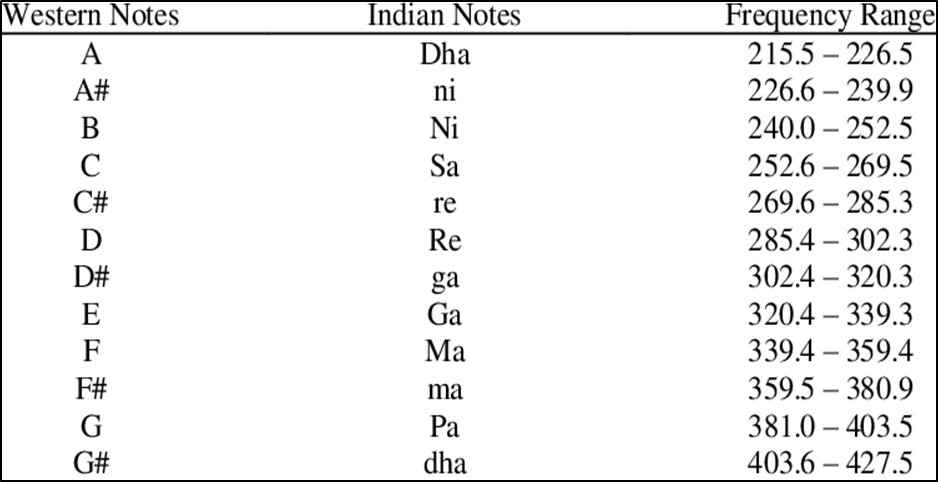
INDIAN CLASSICAL AND SPIRITUAL MUSIC AS A HEALING INSTRUMENT
Thus, Indian music gives much freedom and space to be used as a therapeutic instrument for emotional regulation and healing. Knowing healing frequencies, we can set the base note Sa; knowing the Vadi (principle, «king» note) of raaga, we can understand, which chakra it will affect mostly.
In recent studies Indian researchers proved that music therapy based on Indian Classical Music and practice of Naad yoga decrease the level of depression and reduce the level of mental disorders. [12]
Indian scholars G. Saraswati and S. Mohan studied the effect Indian music at genetic, cellular and neurophysiological level. In their article they state: «Our brain responds to music by releasing serotonins (a monoamine neurotransmitter), which contributes to the feeling of well-being and happiness. Listening to music also releases mood enhancing chemicals like dopamine, melatonins and endorphins. Music may also boost an endocannabinoid anandamide (the molecule of bliss), body’s own antidepressant. … Music not only affects our brain, but also our DNA and cells. … Our endocrine gland system is interestingly very much responsive to the vibration of musical notes. In fact, our body functions harmoniously as the orchestration of the endocrine system. … We conclude that, music therapy offers an effective alternative for regenerative biology and can be used for regeneration of stem cells in vitro or in our body.» [13]
In the same research work the frequency of vibrations of the spectrum of emotions was provided, which is given on the picture below[11] (Fig.4). We see that the flow of energy and frequency of vibration increases from the bottom up. The scientists state that «the first musical note Sa has a frequency of 262 Hz and so on; thereby it helps the listener/practitioner to resonate with the corresponding high vibration emotion in the spectrum». Other than pleasure, the effects of music increase in high vibration emotions like joy, peace, etc., and reduce the low vibration emotions like anxiety, fear, anger etc. [13]
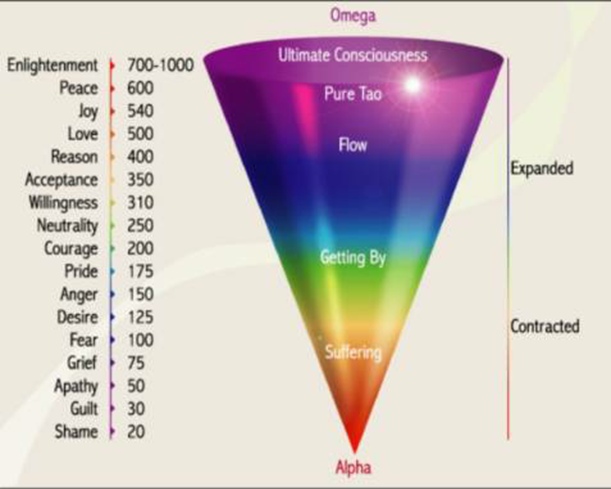
Fig.4 Spectrum of emotions with related frequencies
Рис.4. Спектр эмоций с родственными частотами
G. Saraswati and S. Mohan declare: “In our observations of behavioural psychology, regular practitioners of music show an observable positive qualitative difference in comparison to non-practitioners. They are less stressed, their anxiety levels are low, more clam and more grounded. Children, who listen to or practice music regularly, have found have better learning, memory and concentration, less aggression and better anger and stress management in comparison to the ones, who don’t. Neurophysiology study shows their brain to be in Alpha (relaxed) state with slower and deeper breathing, better heart rate and parasympathetic predominance. They are spiritually more advanced than other beings as they vibrate higher. Music has also been seen to improve quality of life in healthy individuals.” [13]
CONCLUSIONS
Practice of Indian classical and spiritual music on any level (note practice, chanting of mantras, learning raagas) is a pleasurable practice of harmonizing mind, body and soul. It can never harm anyone, but it gives so many benefits:
- Self-regulation: by singing we control breathing, by note practice (alankars) we control the mind and give good exercise for our cognitive system;
- Energy charging: by proper note we turn the energy in chakra (every chakra is like a lock, and proper note is a key);
- Energy balance: by practicing raag we learn to call some specific good energy, we balance our energy, aura;
- Self-expression: by singing we express all inner emotions (we don't keep them inside, so they don't accumulate and create illness);
- Spiritual growth: by devotional singing we concentrate our minds on the higher forms, feelings. It's a beautiful and blissful path of spiritual growth;
- Creating healthy atmosphere: by listening of raagas we can change our mood into positive one and uplift our energy level etc.
Thus, Indian classical and spiritual music is a deep healing and uplifting spiritual science, kind of Yoga, which can be practiced everywhere and by anyone. It requires more study and more further researches, which for sure will bring much benefit to humanity as it has already proved its effectivity through centuries by harmonizing and enriching life of people.
1. Paramhans Swami Maheshwarananda, The Hidden Power in Humans: Chakras and Kundalini - International Sri Deep Madhavananda Ashram Fellowship, 2012.
2. Totton, N. Body Psychotherapy: An Introduction Open University Press., 2003.
3. Macnaughton, I., Body, Breath and Consciousness: A Somatics Anthology, North Atlantic Books., 2004.
4. Raga Concept - Indian Music https://www.culturopedia.com/raga-and-tala
5. Saumyaa Vardhan, Mantra: An object of scientific research, New Delhi, 2018 https://indianexpress.com/article/religion/mantra-object-scientific-research-5150138
6. Jai Dudeja, Scientific Analysis of Mantra-Based Meditation and its Beneficial Effects: An Overview - International Journal of Advanced Scientific Technologies in Engineering and Management Sciences 3(6):21, 2017.
7. Ivonin, L., Chang, HM. Chen, W. Quantifying and logging something we are not aware of - Personal Ubiquitous Computing Unconscious Emotions, 2019.
8. Hulse D. Specifications of A Fork in the Road: An Inspiring Journey of How Ancient Solfeggio Frequencies Are Empowering Personal and Planetary Transformation. Authorhouse, USA, 2009.
9. Frequency Therapy in Music, BRMI, 2021 https://www.biologicalmedicineinstitute.com/post/2019/09/25/frequency-therapy-in-music
10. Calamassi, Diletta, and Gian Paolo Pomponi. Music tuned to 440 Hz versus 432 Hz and the health effects: a double-blind cross-over pilot study. EXPLORE, Vol. 15, Issue 4, Jul-Aug 2019
11. Samarjit Roy, Sudipta Chakrabarty, Debashis De - Time-Based Raga Recommendation and Information Retrieval of Musical Patterns in Indian Classical Music - Using Neural Networks, IAES International Journal of Artificial Intelligence (IJ-AI) Vol. 6, No. 1, March 2017.
12. Vivek Maheshwari, Amit Tiwari - Effect of Naad Yoga (Music Therapy) on Depression, Creative Research Journal, Arunachal University of Studies, March 2021.
13. Govind Saraswati, Sonali Mohan - Have you Wondered Why Music is so Wonderful - Centre for Advanced Research in Indian Music Therapy, Dwarka, New Delhi, India. November 11, 2019.
